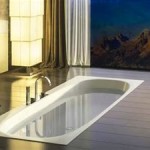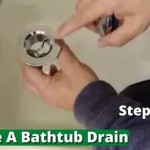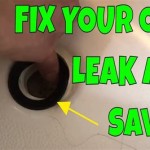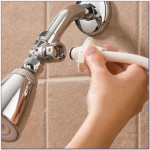Hot Water Won't Turn Off in Bathtub Tower: Troubleshooting and Solutions
A persistent problem in many residential and commercial buildings is hot water that refuses to shut off completely at the bathtub faucet. This issue, sometimes referred to as a "hot water won't turn off in bathtub tower" situation, can lead to significant water wastage, increased energy bills, and potential damage to plumbing fixtures and surrounding structures. Understanding the potential causes and appropriate troubleshooting steps is crucial for resolving this frustrating and costly predicament.
The term "bathtub tower" often refers to the vertical plumbing structure behind the bathtub faucet, encompassing the mixing valve, diverter valve (if present for shower functionality), and associated piping. Within this tower, several components can malfunction and contribute to the persistent hot water flow. Identifying the specific component at fault is the first step toward effective remediation.
Several factors can contribute to the hot water's inability to shut off. These range from simple issues solvable with basic tools to more complex problems requiring professional plumbing assistance. Determining the root cause often involves a systematic process of elimination, starting with the most common and easily addressed possibilities.
Faulty Faucet Cartridge or Valve
The most frequent cause of a hot water faucet failing to shut off completely is a worn, damaged, or corroded faucet cartridge or valve. Bathtub faucets generally employ one of several valve types: compression valves, ball valves, cartridge valves, or ceramic disc valves. Each type has a different mechanism for controlling water flow, but all are susceptible to wear and tear over time.
Compression valves, the oldest type, utilize a rubber washer that compresses against a valve seat to shut off the water. Over time, this washer can degrade, crack, or become dislodged, preventing a complete seal. Ball valves use a ball with holes drilled through it to control water flow. Mineral buildup or corrosion can obstruct the ball's movement or damage the sealing surfaces, leading to leaks and an inability to fully shut off the water.
Cartridge valves contain a cylindrical cartridge with internal seals that regulate water flow. These cartridges can become clogged with sediment, mineral deposits, or debris, hindering their ability to move freely and create a tight seal. Similarly, ceramic disc valves, although durable, can suffer from scratches or cracks on the ceramic discs, or from debris lodging between the discs, compromising their sealing capability.
To diagnose a faulty cartridge or valve, first, shut off the water supply to the bathroom at the main shutoff valve or individual fixture shutoff valves (if available). This step is crucial for preventing flooding. Next, disassemble the faucet handle and access the cartridge or valve. Visually inspect the component for signs of damage, such as cracks, corrosion, mineral buildup, or a worn washer (in the case of compression valves). If the cartridge or valve appears damaged, replace it with a new one of the same type and size. Ensure the replacement cartridge or valve is compatible with the specific faucet model.
When replacing a cartridge or valve, thoroughly clean the valve seat and surrounding areas to remove any debris or mineral deposits that could impede the new component's performance. Apply a small amount of plumber's grease to the O-rings or seals of the new cartridge or valve to ensure smooth operation and a watertight seal. After installing the new cartridge or valve, reassemble the faucet handle and turn the water supply back on gradually. Check for leaks around the faucet base and handle. If leaks persist, double-check the installation and ensure all connections are tight.
It's important to note that some faucet models require specialized tools for disassembly and cartridge replacement. Consult the faucet manufacturer's instructions or a professional plumber if you are unsure about the proper procedure.
Diverter Valve Issues
If the bathtub also features a shower, the diverter valve could be the source of the problem, even if water is seemingly only leaking from the bathtub faucet. The diverter valve redirects water flow between the bathtub spout and the showerhead. A malfunctioning diverter valve can allow water to continue flowing to the bathtub spout even when it is set to the shower position, or vice versa.
Diverter valves come in several designs, including lift-rod, push-button, and rotating types. Each type has its own failure modes. Lift-rod diverters, commonly found in older installations, often rely on a rubber seal that can deteriorate over time, leading to leakage. Push-button diverters can become stuck or corroded, preventing them from fully engaging or disengaging the flow to the bathtub spout. Rotating diverters, found in more modern faucets, can suffer from similar issues as faucet cartridges, with mineral buildup or damaged seals hindering their operation.
Diagnosing a faulty diverter valve involves observing the water flow when the diverter is activated. If water continues to flow from the bathtub spout even when the diverter is fully engaged to the showerhead, the diverter valve is likely leaking. Similarly, if water drips from the showerhead when the diverter is set to the bathtub spout, the diverter valve is not sealing properly.
Repairing or replacing a diverter valve depends on the specific valve type and faucet model. Some diverter valves can be disassembled and cleaned, while others require replacement of the entire valve assembly. Similar to faucet cartridge replacement, shut off the water supply before attempting any repairs. Carefully disassemble the diverter valve, noting the orientation of each component. Clean any debris or mineral deposits from the valve body and component parts. If the seals are damaged or worn, replace them with new ones.
If the diverter valve is beyond repair, replace it with a new valve compatible with the faucet model. When installing the new valve, ensure all connections are tight and properly sealed. Apply plumber's grease to the O-rings or seals to ensure smooth operation. Test the diverter valve after installation to confirm that it diverts water flow correctly and prevents any leakage.
Mineral Buildup and Corrosion
Regardless of the valve type, mineral buildup and corrosion can significantly impair the functionality of bathtub faucets and contribute to a persistent hot water leak. Hard water, containing high concentrations of calcium and magnesium, can deposit minerals on the internal components of the faucet, hindering their movement and preventing a tight seal.
Corrosion, particularly in older plumbing systems, can also damage the faucet components, leading to leaks and an inability to shut off the water. Corrosion is more likely in areas with acidic water or when dissimilar metals are used in the plumbing system, leading to galvanic corrosion.
Preventing mineral buildup and corrosion involves several strategies. Installing a water softener can reduce the mineral content of the water, minimizing the risk of scale formation. Periodically cleaning the faucet aerator and showerhead can remove mineral deposits that accumulate over time. Flushing the hot water tank annually can also help to remove sediment and mineral buildup that can contribute to plumbing problems.
If mineral buildup is already present, try soaking the affected faucet components in a solution of vinegar and water. Vinegar is a mild acid that can dissolve mineral deposits without damaging the metal parts. Disassemble the faucet and soak the cartridge, valve body, and other components in the vinegar solution for several hours or overnight. After soaking, scrub the parts with a soft brush to remove any remaining mineral deposits. Rinse thoroughly with clean water and reassemble the faucet.
In cases of severe corrosion, the affected faucet components may need to be replaced. Replacing corroded pipes or fittings can also improve water quality and prevent future corrosion problems.
Addressing a "hot water won't turn off in bathtub tower" situation requires a methodical approach, starting with identifying the potential causes and then implementing appropriate troubleshooting steps. By carefully examining the faucet components, identifying any damage or mineral buildup, and replacing faulty parts, it is often possible to resolve the problem and prevent further water wastage and costly repairs. If the problem persists or if you are uncomfortable performing plumbing repairs, consulting a qualified plumber is recommended.

Homewerks Worldwide Chrome 2 Handle Wall Mount Utility Faucet 3070 250 Ch B Ws At Com

J B Weld Autoweld Stick 8217 The Home Depot

Lutron Maestro Led Single Pole Dual Touch Light Dimmer Switch

Duravit 700524000000090 No 1 Freestanding Soaker Tub Qualitybath Com

Concealed Wall Mounted Copper Bathtub Basin Faucet Modern Bathroom Luxury With Hot Cold Control

Kohler Ealing Vibrant Brushed Nickel Widespread 2 Handle Watersense Bathroom Sink Faucet With Drain At Com

Homewerks Worldwide Chrome 2 Handle Wall Mount Utility Faucet 3070 250 Ch B Ws At Com

Buell Blast Sdometer Correction Box 107987 149 8217 000

Days Inn By Wyndham Oklahoma City Moore Hotel Reviews Rooms S Hotels Com

Clean Tap Water Isn T Flowing In Virginia S Capital As Residents Find Creative Ways To Cope The Seattle Times








